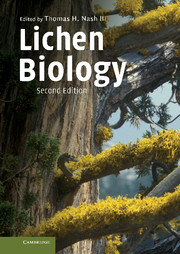Book contents
- Frontmatter
- Contents
- List of contributors
- Preface
- 1 Introduction
- 2 Photobionts
- 3 Mycobionts
- 4 Thallus morphology and anatomy
- 5 Morphogenesis
- 6 Sexual reproduction in lichen-forming ascomycetes
- 7 Biochemistry and secondary metabolites
- 8 Stress physiology and the symbiosis
- 9 Physiological ecology of carbon dioxide exchange
- 10 The carbon economy of lichens
- 11 Nitrogen, its metabolism and potential contribution to ecosystems
- 12 Nutrients, elemental accumulation, and mineral cycling
- 13 Individuals and populations of lichens
- 14 Environmental role of lichens
- 15 Lichen sensitivity to air pollution
- 16 Lichen biogeography
- 17 Systematics of lichenized fungi
- Appendix: Culture methods for lichens and lichen symbionts
- References
- Taxon index
- Subject index
14 - Environmental role of lichens
Published online by Cambridge University Press: 05 September 2012
- Frontmatter
- Contents
- List of contributors
- Preface
- 1 Introduction
- 2 Photobionts
- 3 Mycobionts
- 4 Thallus morphology and anatomy
- 5 Morphogenesis
- 6 Sexual reproduction in lichen-forming ascomycetes
- 7 Biochemistry and secondary metabolites
- 8 Stress physiology and the symbiosis
- 9 Physiological ecology of carbon dioxide exchange
- 10 The carbon economy of lichens
- 11 Nitrogen, its metabolism and potential contribution to ecosystems
- 12 Nutrients, elemental accumulation, and mineral cycling
- 13 Individuals and populations of lichens
- 14 Environmental role of lichens
- 15 Lichen sensitivity to air pollution
- 16 Lichen biogeography
- 17 Systematics of lichenized fungi
- Appendix: Culture methods for lichens and lichen symbionts
- References
- Taxon index
- Subject index
Summary
Although earlier literatures provided an insight into the uniqueness of lichens, it gave little hint of the major role these apparently insignificant organisms play in the shaping of the physical and biological environment of our planet and their importance in maintaining its equilibrium. Their role as biological weathering agents in the development of soils, for example, was formerly considered in a geological context only, but recent research has shown that these organisms are capable of biodeteriorating stone substrates within a relatively short timescale. Information is now available to demonstrate that lichens can often contribute substantial biomass and support a high biodiversity of micro- and macroorganisms, creating complex food webs and adding significantly to energy flow (Chapter 10) and mineral cycling (Chapter 12).
The disappearance of lichens, due to many aspects of human interference in the natural world, has therefore led inexorably to environmental impoverishment. Lichens are natural sensors of our changing environment: the sensitivity of particular lichen species and assemblages to a very broad spectrum of environmental conditions, both natural and unnatural, is widely appreciated. Lichens are therefore used increasingly in evaluating threatened habitats, in environmental impact assessments, and in monitoring environmental perturbations, particularly those resulting from a disturbingly large and growing number of chemical pollutants (Chapter 15). Nevertheless, lichens undoubtedly represent one of the most successful forms of symbiosis in nature.
- Type
- Chapter
- Information
- Lichen Biology , pp. 274 - 298Publisher: Cambridge University PressPrint publication year: 2008
- 37
- Cited by

